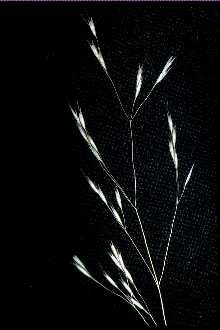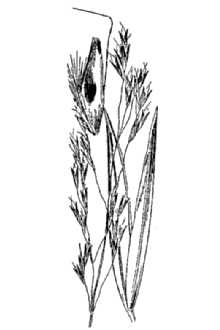Annual Hairgrass
Scientific Name: Deschampsia danthonioides (Trin.) Munro

| General Information | |
|---|---|
| Usda Symbol | DEDA |
| Group | Monocot |
| Life Cycle | Annual |
| Growth Habits | Graminoid |
| Native Locations | DEDA |
Plant Guide
Use soil moisture sensors to measure the soil moisture of Annual Hairgrass.
Fact Sheet
Alternate Names
Other scientific names include Aira danthonioides Trin., Deschampsia calycina J. Presl, and Deschampsia danthonioides (Trin.) Munro var. gracilis (Vasey) Munz
Uses
Annual hairgrass is useful for wetland restoration, erosion control, and revegetation of other moist, disturbed areas where quick, low growing ground cover is desired. Given its apparent lack of competitiveness, this species may prove valuable as a temporary nurse crop for establishing perennial native species in both wetland and upland seed mixes. Waterfowl and birds eat the seeds. However, the foliage may be of less merit for wildlife herbage and cover compared to other grasses because of its short stature, lifespan, and limited productivity. The palatability and nutritional value of annual hairgrass for livestock and game is not documented. The vernal pools which it occupies are important reservoirs for aquatic invertebrates and amphibians.
Status
Please consult the PLANTS Web site and your State Department of Natural Resources for this plant’s current status (e.g. threatened or endangered species, state noxious status, and wetland indicator values).
Description and Adaptation
Adaptation
Adaptation
Dale Darris USDA NRCS Corvallis PMC Annual hairgrass is a fine textured, native, cool season grass with smooth, slender stems (culms) that are 10 to 60 cm tall, The form is upright to spreading, short, and somewhat tufted, The narrow leaf blades are hairless, rough on the edges, slightly in-rolled, 0,5 to 1,5 (2) mm wide, and 1 to 10 cm long, Flower heads (panicles) are open, 7 to 25 cm long, with ascending lower branches, Annual hairgrass occurs from near sea level at the coast to 8000 feet in the Rocky Mountains, It is primarily found from Alaska south to Baja California and east to Montana and New Mexico; also the Northeast US and Chile, Key to identification: Annual hairgrass can be distinguished from slender hairgrass (Deschampsia elongata) and tufted hairgrass (Deschampsia caespitosa) by its weaker root development, fewer leaves, and smaller stature, Without close inspection it may be confused with other annual grasses, such as annual fescues (Vulpia spp,), Both may occur in waste areas, Consult botanical keys for proper identification, Relative abundance in wild: While most common in the Pacific Coast states, the species can still be hard to locate, However, it can occur in large stands, especially in vernal pools dominated by annuals, Use soil moisture sensors to measure the soil moisture of Annual Hairgrass., Seed retention is fair and fill is good, The period for wild collection can extend several weeks as maturation progresses along a soil moisture gradient within depressions, Adaptation: Annual hairgrass reaches its preeminence in vernal pools, mudflats and other shallow depressions that are ponded in winter and desiccated in summer, In California, habitat also includes alkali and coastal grasslands, the edges of alkali playas, and seasonally or periodically inundated wetlands dominated by annuals, Other habitats can include streambanks, roadsides, drier banks, vernal seepage areas, waste areas, and mountain meadows, Typical substrates appear to be acidic (pH 5) to moderately alkaline fine textured clay soils and silt loams above a shallow, impervious layer, However, it also grows on coarse textured substrates that stay moist through seed development, Annual hairgrass apparently tolerates some salinity and prefers full sun, Fall germinants actively grow all winter, tolerating several days to several weeks of continual submergence,
Establishment
Annual hairgrass germinates readily and is easy to establish on open, moist ground. There is no seed dormancy and therefore no requirement for physiological conditioning or over wintering outdoors. However, as a winter annual in milder growing climes of the West Coast, it is best suited to early fall sowing. The seed should be run through a debearder or brush machine to remove pubescence (hairs). This will accentuate further seed cleaning and improve flow through a drill and other planting device. There are approximately 900,000 seeds per pound (+/- 30%). A seeding rate of 1 lb/acre pure live seed (PLS) would result in 20 live seeds per square foot. Seeding rates will vary widely depending on planting purpose, site conditions, and method used.
Management
As an annual, this species requires regular disturbance or moist to wet open ground in fall and winter in order to proliferate. It is not competitive and is easily replaced by other species. Annual hairgrass should be well suited to moist soil management techniques (slow de-watering, disking, etc.) in shallow water impoundments and other controlled wetlands. Such methods are used to improve habitat for waterfowl, shorebirds and other wildlife by maximizing seed production of annuals. Line drawing reprinted with permission, University of Washington Press
Plant Traits
Growth Requirements
| Temperature, Minimum (°F) | 52 |
|---|---|
| Adapted to Coarse Textured Soils | Yes |
| Adapted to Fine Textured Soils | Yes |
| Adapted to Medium Textured Soils | Yes |
| Anaerobic Tolerance | Low |
| CaCO3 Tolerance | Medium |
| Cold Stratification Required | No |
| Drought Tolerance | Medium |
| Fertility Requirement | Low |
| Fire Tolerance | High |
| Frost Free Days, Minimum | 145 |
| Hedge Tolerance | None |
| Moisture Use | Medium |
| pH, Maximum | 7.2 |
| pH, Minimum | 5.8 |
| Precipitation, Maximum | 30 |
| Precipitation, Minimum | 12 |
| Root Depth, Minimum (inches) | 6 |
| Salinity Tolerance | None |
| Shade Tolerance | Intermediate |
Morphology/Physiology
| After Harvest Regrowth Rate | Slow |
|---|---|
| Toxicity | None |
| Shape and Orientation | Erect |
| Nitrogen Fixation | None |
| Resprout Ability | No |
| Active Growth Period | Spring and Summer |
| Bloat | None |
| C:N Ratio | Medium |
| Coppice Potential | No |
| Fall Conspicuous | No |
| Fire Resistant | No |
| Flower Color | Yellow |
| Flower Conspicuous | No |
| Foliage Color | Green |
| Foliage Porosity Summer | Porous |
| Foliage Texture | Fine |
| Fruit/Seed Color | Brown |
| Fruit/Seed Conspicuous | No |
| Growth Form | Bunch |
| Growth Rate | Moderate |
| Height, Mature (feet) | 1.5 |
| Known Allelopath | No |
| Leaf Retention | No |
| Low Growing Grass | No |
| Foliage Porosity Winter | Porous |
Reproduction
| Propagated by Seed | Yes |
|---|---|
| Propagated by Sod | No |
| Propagated by Sprigs | No |
| Propagated by Tubers | No |
| Fruit/Seed Persistence | No |
| Seed per Pound | 1000000 |
| Seed Spread Rate | Moderate |
| Seedling Vigor | High |
| Small Grain | No |
| Vegetative Spread Rate | None |
| Propagated by Corm | No |
| Propagated by Container | No |
| Propagated by Bulb | No |
| Propagated by Bare Root | No |
| Fruit/Seed Period End | Summer |
| Fruit/Seed Period Begin | Spring |
| Fruit/Seed Abundance | High |
| Commercial Availability | Routinely Available |
| Bloom Period | Mid Spring |
| Propagated by Cuttings | No |
Suitability/Use
| Veneer Product | No |
|---|---|
| Pulpwood Product | No |
| Protein Potential | Low |
| Post Product | No |
| Palatable Human | No |
| Palatable Graze Animal | Low |
| Palatable Browse Animal | Low |
| Nursery Stock Product | No |
| Naval Store Product | No |
| Lumber Product | No |
| Fodder Product | Yes |
| Christmas Tree Product | No |
| Berry/Nut/Seed Product | No |

